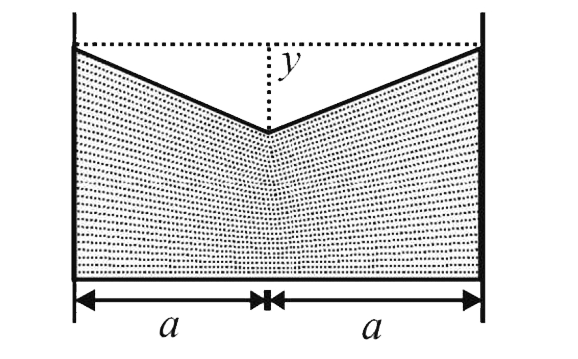Complete Solutions to Solved Examples of chapter PROPERTIES OF SOLIDS AND FLUIDS of Class 11 book with complete answers and questions
| Class 11 | PHYSICS |
| Chapter | PROPERTIES OF SOLIDS AND FLUIDS |
| CENGAGE PHYSICS | Solved Examples |
| Number Of Questions | 11 |
| Academic Year | 2023-24 |
A boy has a catapult made of a rubber cord of length `42 cm` and diameter `6.0 mm`. The boy stretches the cord by `20 cm` to catapult a stone of mass `20 g`. The stone flies off with a speed of `20 ms^(-1)`. Find Young's modulus for rubber. Ignore the change in the cross section of the cord in streching.
View SolutionA steel wire of cross-sectional area `0.5mm^2` is held between two fixed supports. If the wire is just taut at `20^@C`, determine the tension when the temperature falls to `0^@C`. Coefficient of linear expansion of steel is `1.2 xx 10^(-5 @)C(-1)` and its Young's modulus is `2.0 xx 10^11 N m^(-2)`.
View SolutionA sphere of radius `10 cm` and mass `25 kg` is attached to the lower end of a steel wire which is suspended from the ceiling of a room. The point of support is `521 cm` above the floor. When the sphere is set swimming as a simple pendulum, its lowest point just grazes the floor. Calculate the velocity of the ball at its lowest position.
View SolutionA steel bolt is insertede into a copper tube as shown in the figure. Find the forces induced in the bolt and in the tube when the nut is turned through one revolution. Assume that the length of the tube is `l`, the pitch of the bolt thread is `h` and the cross sectional areas of the steel bolt and the copper tube are `A_(s)` and `A_(c)` respectively.

View SolutionA circular ring of radius `R` and mass `m` made of a uniform wire of cross sectional area `A` is rotated about a stationary vertical axis passing throgh its centre and perpendicular to the plane of the ring. If the breaking stress of the material of the ring is `sigma_(b)`, then determine the maximum angular speed `omega_("max")` at which the ring may be rotated without failure.
View SolutionA glass plate of lengthh `10 cm`, breadth `1.54 cm` and thickness `0.20 cm` weight `8.2 g` in air. It is held vertically with the long side horizontal and the lower half under water. Find the apparent weight of the plate. Surface tension of water `=7.3xx10^(-2)N//m` and `=9.8ms^(-12)`
View SolutionA barometer contains two uniform capillaries of radii `1.4xx10^(-3)m` and `7.2xx10^(-4)m`. If the height of liquid in narrow tube is `0.2m` more than that in wide tube, calculate the true pressure difference. Density of liqid `=10^(3)kg//m^(3)`, surface tension `=72xx10^(-3)N//m` and `g=9.8ms^(-12)`.
View SolutionA glass capillary sealed at the upper end is of length `0.11 m` an internal diameter `2xx10^(5)`m. The tube is immersed vertically into a liquid of surface tension `5.06xx10^(-N)//m`. To what length the capillary has to be immersed so that the liquid level inside and outside the capalliary becomes the same. What will happen to water level inside the capillary if the seal is now broken?
View SolutionAn open capillary tube contains a drop of water. When the tube is in its vertical position, the drop forms a column with a length of a `2cm`, b. `4cm`, and c. `2.98cm`. The internal diameter of the capillary tube is `1mm`. Determine the radii of curvature of the upper and lower meniscuses in each case. Consider the wetting to be complete. Surface tension of water `=0.0075N//m`
View SolutionTwo spherical soap bubble coalesce. If `V` is the consequent change in volume of the contained air and `S` the change in total surface area, show that
`3PV+4ST=0`
where `T` is the surface tension of soap bubble and `P` is
Atmospheric pressure
View SolutionA uniform wire having mass per unit length `lambda` is placed over a liquid surface. The wire causes the liquid to depress by `y(y lt lt a)` as shown in figure. Find surface tension of liquid. Neglect end effect.

View Solution
Solved Examples questions and complete solutions for chapter PROPERTIES OF SOLIDS AND FLUIDS of CENGAGE PHYSICS (HINGLISH) of Class 11